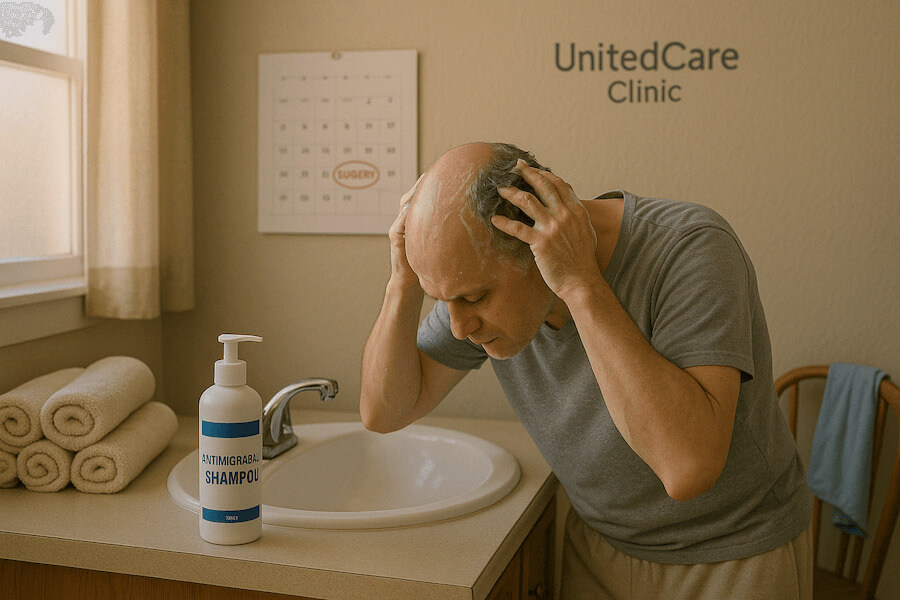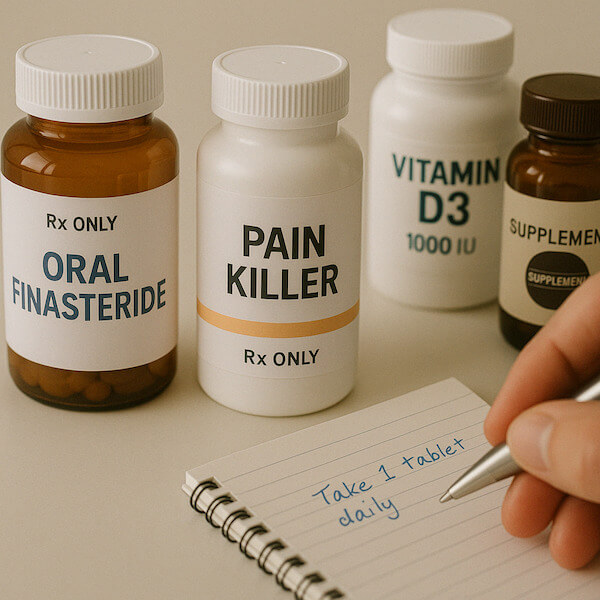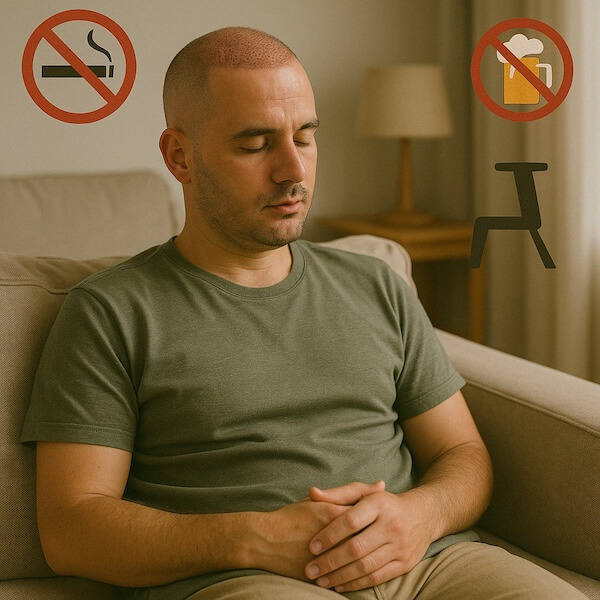Care Assistant
The easiest way to follow pre- and post-operative hair transplant instructions.
How to use?
References
[1] Postoperative Expectations and Instructions, Samuel L. Oyer, 2020, Source
[2] Vitamin E Serum Levels and Bleeding Risk in Patients Receiving Oral Anticoagulant Therapy: a Retrospective Cohort Study, Pastori, Carnevale, Cangemi, Saliola, Nocella, Bartimoccia, Vicario, Farcomeni, Violi, Pignatelli, 2013, Source
[3] On the mechanism of the anticlotting action of vitamin E quinone, Dowd, Zeng, 1995, Source
[4] Sorensen LT. Wound healing and infection in surgery: the pathophysiological impact of smoking, smoking cessation, and nicotine replacement therapy: a systematic review. Ann Surg. 2012;255(6):1069–79.
[5] Coon D, Tuffaha S, Christensen J, Bonawitz SC. Plastic surgery and smoking: a prospective analysis of incidence, compliance, and complications. Plast Reconstr Surg. 2013;131(2):385–91. )
[6] The Art of Follicular Unit Micrografting and Minigrafting, Second Edition, Fisher Jack, 2015, Source
[7] Nutrition, Supplements, and Vitamins in Platelet Function and Bleeding, Violi, Pignatelli, Basili, Source
[8] Vitamin C: a wound healing perspective, Jane Moores, Source
Comprehensive Guide on Hair Transplant Post Op Aftercare
If you’re looking for a detailed guide on hair transplant post op aftercare, then you are in the right place. In this article, you’ll find our After Hair Transplant Guideline designed in plain language so that you know exactly How To Take Care of Hair After a Hair Transplant. From the day of surgery up to long-term maintenance, every topic is covered as per the instructions provided.
Note: We have included every subject — surgery day routines, medications, diet, activities, hair care and wash, sleep positions, and hair/scalp status — to leave no stone unturned, even mentioning keywords like shower, swim, and sex where needed.
1. Surgery Day Guidelines
Morning Hair Wash with Anti-Microbial Shampoo:
On the surgery day, start your day by washing your hair with an anti-microbial shampoo. Use a gentle hair wash with no styling products—this helps keep the scalp as clean as possible.
Light Breakfast (If Sedation Is Not Used):
If you are not receiving sedation, a light breakfast is recomended. However, if sedation is on the card, avoid eating anything in the morning.
Clothing Choice:
Wear comfortable, loose-fitting clothing such as a button-down shirt that does not need to be pulled over your head. This ensures that post op dressing and changes are easier to handle.
Avoid Caffeine:
It is important to refrain from caffeine on the op day. Caffeine could have unwanted effects and should be avoided.

2. Medications
Following the precise medication guidelines is crucial.
- Oral Finasteride (Propecia©):
Continue this medication between 90 days pre-op and 365 days post-op. It plays a role in maintaining the hair growth cycle. - Pain Killers:
Typically used for 3 days post-op, these are prescribed to ease the immediate discomfort. - Aspirin, Ibuprofen, and NSAIDs:
These are forbidden for 10 days before surgery due to their bleeding risk. This also applies to many common over-the-counter pain, cold, flu, and allergy meds containing these ingredients. - Certain Herbals:
Supplements like echinacea, garlic, ginkgo biloba, ginseng, ginger etc. are banned 10 days pre-op for the same bleeding risk. - Blood Thinners (Anticoagulants):
Avoid these 7 days before surgery as they can significantly interfere with blood clotting. - Topical Rogaine/Minoxidil:
Allowed between 30 and 365 days post-op to aid in hair growth support. - Rogaine/Minoxidil (Oral/Topical):
This is forbidden for 7 days pre-op. - Post-op ATPv Spray:
Use this spray for 2 days post-op to provide an optimal medium for graft survival and recovery.

3. Diet & Supplement Guidelines
What you eat can really impact your healing process.
- Vitamin E and Vitamin E Quinone:
These are forbidden for 14 days before the op because they reduce blood coagulation too much. - Vitamin B and Niacin:
Also forbidden for 7 days pre-op. Foods high in Vitamin B (like leafy vegetables, egg yolk, mayonnaise, etc.) should be avoided as they can increase bleeding risk. - Supplements:
Any supplement intake such as protein powders, bcaa’s and other vitamins are to be avoided 7 days pre-op. - Vitamin C:
Always beneficial, it is particularly recommended for 7 days pre-op. Start with 1000mg taken three times per day for better healing. - Mandatory Proper/Balanced Diet:
Maintaining a healthy-balanced diet during the first 3 months post-op is important for a faster recovery.

4. Activities During Recovery
Your activities after surgery need to be carefully selected:
- Smoking and Nicotine:
Smoking is forbidden from 14 days pre-op until 7 days post-op because it decreases blood flow to the scalp. - Alcohol Consumption:
Avoid alcohol 7 days before and 14 days after the op; it can elevate complication risks. - Head Movement:
Keep your head still and avoid bending for at least 4 days post-op in order to minimise swelling. - Returning to Work:
It is advisable to refrain from going back to work for 7 days post op. - Heavy Activity and Exercise:
Any heavy physical activities or exercises should be avoided between 7 days pre-op and 30 days post-op.- Even if you enjoy light sports or exercise like yoga or pilates, it’s forbidden for the first two weeks post-op.
- Other Precautions:
- Be careful while sneezing: Take extra care in the first month post-op.
- Swimming and Seawater Exposure: Swimming is banned in the first month; exposure to seawater is forbidden for 5 days post-op.
- Sexual Intercourse: This activity is not allowed for 7 days post-op.
- Head Coverings: Hats, helmets, and similar items should be avoided during the first month.
- Sun Exposure: Keep out of strong sunlight for the first month.
- Graft/Recipient Area Touching: Do not touch these areas for 15 days.
- Scratching: Avoid scratching for the first month.
- Sauna and Solarium: Both are forbidden; sauna for the first month, and solarium usage is a no-go for 6 months post-op.
- Dusty and Polluted Areas: Also, try to avoid such areas for 15 days post-op.

5. Hair Care and Wash Instructions
Your hair wash techniques post op are key for preventing infections and ensuring graft survival.
- Following Washing Instructions:
For 15 days post-op, follow the specific washing instructions given by your clinic. - Shower:
A shower is not allowed until at least 24 hours after surgery. When you do shower, gently apply a prescribed shampoo over the graft sites, let it sit for 2–3 minutes, then rinse by gently pouring water. - Water Temperature & Pressure:
Always use warm water with low pressure. Hot and high-pressure water could jeopardize the grafts in the first month post-op. - Use of Special Shampoo:
Only use the special shampoo provided to you for 14 days after the op. - Avoid Natural Moisturizers for Dry Scalp:
Regular moisturizers, like oil-based or coconut creams, are forbidden for the first 10 days. Only use those recommended by your dermatologist. - Soft Towel and Blow Dryer:
Do not use even soft towels or blow dryers (unless on cold air after 3 days post-op) in the initial period. - Applying Ice Packs:
Ice packs can be applied for 5 days post-op but make sure not to put them directly on the transplanted areas. - Haircut & Hair Styling Products:
Go easy on hairdresser visits for the first month. Avoid hair dye and styling products for up to 6 months. If you need a trim, use scissors only, but not before 6 months post-op. - Hairpiece/Extensions & Brushing:
No extensions or toupees in the first year and avoid gentle combing or brushing of both donor and recipient areas until advised otherwise by your surgeon.
6. Sleep Position & Hygiene
Getting the right sleep is essential for recovery.
- Using a Neck Pillow (U-Shaped):
For 10 days after the surgery, it is recomended to use a U-shaped neck pillow to relieve pressure in the donor area. - Sleeping Face Up with a 45-Degree Elevation:
Sleeping with your face elevated (by 45 degrees) for 10 days post-op can help reduce swelling and promote better healing. - Changing Sheets and Pillowcases Regularly:
Maintain strict hygiene by changing bedding regularly for at least the first 10 days post op to avoid any infections.
7. Hair/Scalp Status and Monitoring
Post-op healing also involves monitoring your hair and scalp.
- Swelling and Burning Sensation:
Expect some swelling (up to 7 days) and a burning sensation (around 5 days) in both donor and recipient areas. - Numbness and Reddish Skin:
Numbness can persist for up to 31 days, while slight redness may be visible on the scalp in the first month. These are all part of the normal healing process. - Scabs Falling Out:
It is completely normal for scabs to fall out around 12 days after the surgery. - Transplanted Hair Shedding:
Transplanted hair may shed between 16 and 60 days post-op – known as shock loss. Don’t be alarmed as it will regrow usually after 60 days. - Visible New Hair Growth:
You won’t see visible new hair growth until after the third month, so be patient. - Shock Loss and Noticeable End Result:
Shock loss is normal (often seen between 60-180 days) and the noticeable end result of your transplant will typically be seen after 12-18 months.
Quick Summary
Every aspect of your surgery and recovery—from the day of surgery, through your medications and diet, to careful post op activities, proper hair care, sleep positions, and monitoring your hair/scalp status—is critical for the overall success of your hair transplant. Remember that these guidelines are designed to help you achieve the best possible outcome. Stay in close contact with your hair transplant team and follow the instructions exactly as provided. Even if it seems a bit strict, adherence to these instructions can significantly impact the long term results.
Take care and be patient—good results need time to fully develop, so stick to your aftercare plan and allow your body to heal properly.
Happy healing and best wishes on your journey to restored hair confidence!